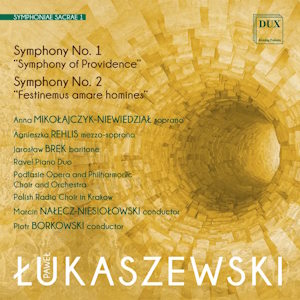
Pawel Łukaszewski (b. 1968)
Symphony No. 1 ‘Symphony of Providence’ (1997-2008)
Symphony No. 2 ‘Festinemus amare homines’ (2003-5)
Anna Mikołajczyk-Niewiedział (soprano), Agnieszka Rehlis (mezzo-soprano), Jarosław Brek (baritone)
Ravel Piano Duo
Polish Radio Choir in Krakow
Podlaste Opera and Philharmonic Choir and Orchestra/Marcin Nałecz-Niesiołowski (1), Piotr Borkowski (2)
rec. 2007, Concert Hall of the Fryderyk Chopin Academy of Music, Warsaw; 2009, St Adalbert’s Church in Bialystock, Poland
DUX 1844 [69]
In Britain Łukaszewski is best known as a composer of church choral music, of which several recordings have appeared. But in his native Poland he is as well known for his orchestral works. There are, so far, eight symphonies, seven concertos and a number of other orchestral pieces. Symphonies No. 3 and 6 have already appeared on the Dux label (review), under the heading Symphoniae Sacrae 2 and now we have the first two, with the heading Symphoniae Sacrae 1.
These are both choral works, and, indeed, there is an immediate continuity with the works by which he is better known in that they are both choral works on sacred themes. The first symphony is titled Symphony of Providence, and its subject is God’s protection of his people. There are four movements. Gaudium et spes (Joy and hope) for soprano, chorus and orchestra sets a passage from one of the documents of the second Vatican Council, which was the Council which opened up the Roman Catholic Church to the modern world. The second movement, Exultet (Rejoice) sets a passage from the hymn of that name, which is sung by the celebrant at the Easter Vigil, the most sacred occasion in the Christian year, celebrating Christ’s resurrection. The third movement, Terra Nova et caelum sets the passage from the Revelation of St John about the new earth and the new heaven which will come about at the end of time. The fourth movement, Et exspecto resurrectionem mortuorum (And I look for the resurrection of the dead) sets an invocation to Love and a short passage from the Creed. The work requires three soloists, chorus and a large orchestra, without upper woodwind but with plenty in the way of gongs and bells.
This opens very impressively with the chorus, with brass and bells prominent. It reminded me immediately of the opening of Szymanowski’s King Roger, the scene set in the cathedral. There is an extended passage for strings and a soprano solo. Exultet in contrast is calmer and quieter, starting with an orchestral passage for strings and then a mezzosoprano solo and women’s voices – it was a woman, Mary Magdalene, who was the first witness of the resurrection. In contrast, Terra Nova begins with male voices and moves gradually upwards, with the women’s voices coming in later and a change from minor to major. The finale begins with a brass fanfare and has a good deal of varied material which includes quotations from the previous movements and a powerful unison for the chorus, symbolizing the unity of the faithful.
The second symphony is similar in that it is also a choral work on sacred themes, this time for two sopranos, two choirs two pianos and an orchestra which this time has no woodwind at all, though a large percussion section. Its title is Festinemus amare homines (Let us hurry to love people) and it is also in four movements. It sets texts by Jan Twardowski (1915-2006) who was both a poet and a Catholic priest. These elaborate the teaching of Pope John Paul II ‘we still love too little and always too late.’ There are four movements, Festinemus (Let us hurry), Tempus (Time), Amamus (We love) and Decedunt (They leave). The four movements correspond to a typical symphony, in that the first movement is in sonata form, the second an adagio, the third a scherzo and the fourth a presto. However, rhythm plays a greater part in this work than it did in its predecessor. And it is also shorter, making it easier to listen to. The first symphony is impressive in a sombre way but also slow-moving and intense. The second is more varied, and the rhythmic vitality is very refreshing.
Both symphonies have been recorded before, but these performances were clearly carefully planned and prepared. The various singers, choirs and orchestras all seem on top of their work, and they give convincing and impressive performances. The recordings are good too, which is important with such complex music. They did, however, take place a number of years ago, as the recording dates above show; I don’t know why it has taken so long for them to reach disc. Still, they will do very well in presenting two important works by a major Polish composer, and we must hope that Dux go on to complete the cycle, and even take not so long about it.
Stephen Barber
Help us financially by purchasing from



















